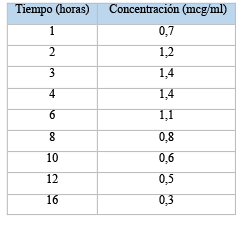Optimum designs for nonlinear models with correlation structure: robustness study
Diseños óptimos para modelos no lineales con estructura de correlación: estudio de robustez


This work is licensed under a Creative Commons Attribution-NonCommercial-NoDerivatives 4.0 International License.
Copyright statement
The authors exclusively assign to the Universidad EIA, with the power to assign to third parties, all the exploitation rights that derive from the works that are accepted for publication in the Revista EIA, as well as in any product derived from it and, in in particular, those of reproduction, distribution, public communication (including interactive making available) and transformation (including adaptation, modification and, where appropriate, translation), for all types of exploitation (by way of example and not limitation : in paper, electronic, online, computer or audiovisual format, as well as in any other format, even for promotional or advertising purposes and / or for the production of derivative products), for a worldwide territorial scope and for the entire duration of the rights provided for in the current published text of the Intellectual Property Law. This assignment will be made by the authors without the right to any type of remuneration or compensation.
Consequently, the author may not publish or disseminate the works that are selected for publication in the Revista EIA, neither totally nor partially, nor authorize their publication to third parties, without the prior express authorization, requested and granted in writing, from the Univeridad EIA.
Show authors biography
This article proposes a methodology to compare exact D-optimal designs when the assumption of incorrectness of the error term in the model is not fulfilled and four covariance structures are taken into consideration to model it. A simplified expression of the Fisher’s information matrix is found for the general case of correlated observations and is used in the four considered covariance structures.
With each covariance structure, the respective optimal design is found, known as the nominal design, and the robustness of the other optimal designs is evaluated by finding their efficiency in relation to the nominal design. It is concluded that the four optimal designs are competitive with respect to the other considered covariance structures, by observing a minimal loss of efficiency of each of these designs and showing that the optimal designs, at least with the considered covariance structures, are robust to the choice of the covariance structure. Additionally, it is shown, via simulation, that, with the optimal designs, under each covariance structure, good estimators are obtained for the model parameters when evaluating the magnitude of the coefficient of variation and the relative mean square error.
Article visits 374 | PDF visits 251
Downloads
- Akaike, H. (1974). A new look at the statistical model identification, IEEE Transactions on Automatic Control, 19(6), 716-723, doi: 10.1109/TAC.1974.1100705.
- Amo, M., López-Fidalgo y López-Ríos, V. (2012). Optimal designs for two nested pharmacokinetic models with correlated observations, Communications in Statistics, 41(1), 944-963, doi: 10.1080/03610918.2012.625743.
- Atkinson, A., Donev, A. y Tobias, R. (2007). Optimum Experimental Designs with SAS, Oxford University Press, New York.
- Baran, S., Szák-Kocsis, C. y Stehlík, M. (2018). D-optimal designs for complex Ornstein–Uhlenbeck processes. Journal of Statistical Planning and Inference, 197, 93-106, doi: 10.1016/j.jspi.2017.12.006.
- Bates, D. y Watts, D. (1988). Nonlinear Regression Analysis and Its Applications, John Wiley & Sons, New York.
- Boukouvalas, A., Cornford, D. y Stehlík, M. (2014). Optimal design for correlated processes with input-dependent noise. Computational Statistics & Data Analysis, 71, 1088-1102, doi: 10.1016/j.csda.2013.09.024.
- Correa-Álvarez, C. D. (2015). Búsqueda de diseños cuasi-óptimos eficientes a partir de un diseño D-óptimo para observaciones correlacionadas espacialmente, tesis (Maestría en Estadística). Universidad Nacional de Colombia Sede Medellín.
- Dette, H., Kunert, J. y Pepelyshev, A. (2008). Exact optimal designs for weights least squares analysis with correlated errors, Statistica Sinica, 18, 135-154, from http://www.jstor.org/stable/24308249
- Dette, H., Pepelyshev, A. y Zhigljavsky, A. (2013). Optimal design for linear models with correlated observations, The Annals of Statistics, 41(1), 143-176, doi: 10.1214/12-AOS1079.
- Dette, H., Pepelyshev, A. y Zhigljavsky, A. (2015). Design for linear regression models with correlated errors. In: Dean, A., Morris, M., Stufken, J., Bingham, D. (Eds.), Handbook of Design and Analysis of Experiments. Chapman & Hall/CRC, Boca Raton, pp. 237–278.
- Dette, H., Pepelyshev, A. y Zhigljavsky, A., (2016). Optimal designs in regression with correlated errors. Ann. Statist. 44, 113–152, doi: 10.1214/15-AOS1361.
- Fedorov, V. y Hackl, P. (1997). Model-Oriented Design of Experiments, Springer, New York.
- Kiefer, J. (1959). Optimum Experimental Designs, Journal of the Royal Statistical Society, 21(1), 272-319, doi: 10.1111/j.2517-6161.1959.tb00338.x.
- Liu, X., Yue, R. X. y Wong, W. K. (2018). D-optimal design for the heteroscedastic Berman model on an arc. Journal of Multivariate Analysis, 168, 131-141, doi: 10.1016/j.jmva.2018.07.003.
- López-Ríos, V. y Ramos-Quiroga, R. (2007). Introducción a los Diseños óptimos, Revista Colombiana de Estadística, 30(1), 37-51, https://www.redalyc.org/pdf/899/89930103.pdf.
- Matérn, B. (1960). Spatial Variation, Springer, New York.
- Müller, W. G., Pronzato, L., Rendas, J. y Waldl, H. (2015). Efficient prediction designs for random fields. Appl. Stochastic Models Bus. Ind., 31, 178-194. doi: 10.1002/asmb.2084.
- Pazman, A. (1986). Foundations of Optimum Experimental Design, D. Reidel Publishing Company, Dordrecht.
- Pazman, A. (2007). Criteria of optimal designs for small-samples experiments with correlated observations, Kybernetica, 43(4), 453-462, https://dml.cz/handle/10338.dmlcz/135787.
- R Core Team (2020). R: A language and environment for statistical, computing. R Foundation for Statistical Computing, Vienna, Austria, URL https://www.R-project.org/.
- Rodríguez-Díaz, J. M., Santos-Martín, M. T., Waldl, H. y Stehlik, M. (2012). Filling and D-optimal designs for the correlated Generalized Exponential models. Chemometrics and Intelligent Laboratory Systems, 114, 10-18, doi: 10.1016/j.chemolab.2012.01.007.
- Schwarz, G. (1978). Estimating the dimension of a model, Annals of Statistics, 6(2), 461-464, doi: 10.1214/aos/1176344136.




